That semen tank sitting in the corner of the barn office or vet room generally goes unnoticed except for the times you are pulling out a dose of semen from one of your favorite sires.
But with some extra attention, you can obtain the best longevity from your semen storage vessel while ensuring the dose you are about to put in the cow or heifer is as fertile as the day it was processed.
Semen tank storage and care
The expected life of a modern storage tank is a minimum of 10 to 12 years, considering proper placement and maintenance.
Liquid nitrogen maintenance
Every six or seven weeks, a rep will monitor liquid nitrogen usage and keep a log on your behalf. The standard 20-liter farm tank has a normal working duration of 142 days and will evaporate 0.09 liter per day, on average. These rates will vary depending how often the tank is opened.
The tank rep will alert the producer if nitrogen evaporation appears to be abnormal; beyond that, the basic maintenance of the semen tank is the producer’s responsibility.
Placement
The tank should be placed in a well-lit and ventilated area. Sufficient light above the tank ensures one can see well down into the neck tube, allowing reference to the frost line. (The importance of the frost line will be discussed.)
While gasification of liquid nitrogen is very slow, we should be aware of the presence of nitrogen gas and consider ventilation. While working out of the standard farm tank, an open door or slightly open window is sufficient.
It is important the tank is not placed directly on concrete, as moisture, minerals and abrasion from the concrete can corrode the aluminum outer shell of the tank. If perforation occurs, vacuum loss and tank failure is certain. Isolating the tank from concrete can be as simple as setting it on a 16- to 18-inch square wooden pallet or rigid foam (Figure 1).
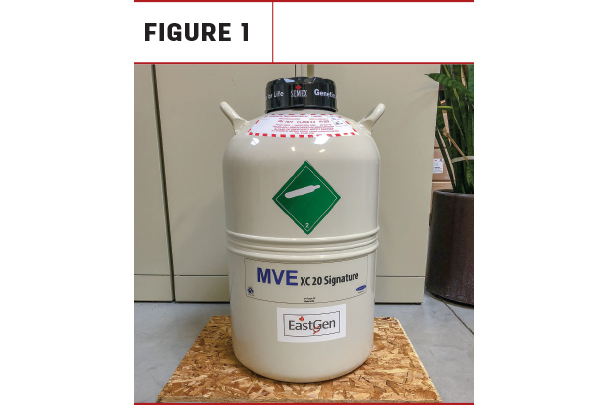 Some choose to take it to the next level and mount the tank on a slide-out incorporated into a cabinet (Figure 2).
Some choose to take it to the next level and mount the tank on a slide-out incorporated into a cabinet (Figure 2).
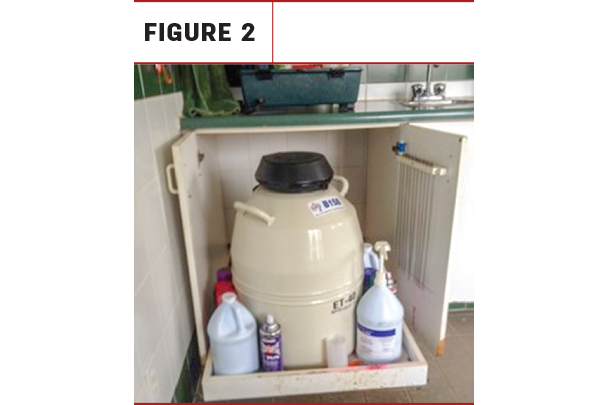 Tank storage in the milkhouse should be avoided as cleaning chemicals can be corrosive to the outer shell, and high temperatures and humidity are not the best environment.
Tank storage in the milkhouse should be avoided as cleaning chemicals can be corrosive to the outer shell, and high temperatures and humidity are not the best environment.
Cleaning
If it is necessary to clean the tank, mild soap and water is sufficient. Rinse carefully while not using a strong jet of water to avoid getting water down into the neck cork. This can freeze the neck cork solidly in place, not allowing nitrogen gas to escape. The build-up in pressure can rupture the tank with disastrous results.
Moving the tank
Move the tank as little as possible. If moving the tank is necessary, lift the tank with both handles to keep it relatively level. If carrying any distance, get help or use a cart; a full tank weighs about 63 pounds. Avoid rough handling or dropping the tank as it can damage the seal between the neck tube and inner liner, resulting in vacuum loss.
Vacuum loss and imminent tank failure is indicated by a rapid frost build-up around the outside of the neck tube (Figure 3).
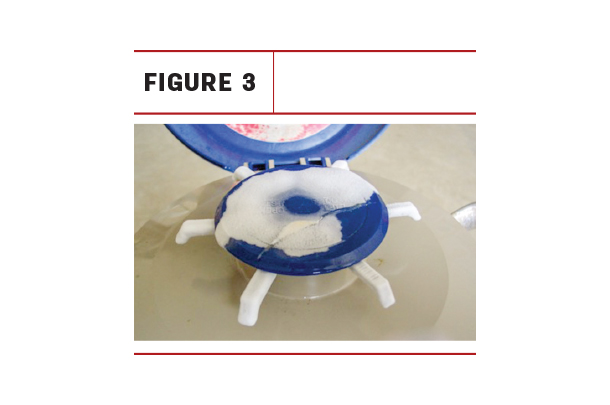 If this is observed, get the semen inventory moved to another tank as soon as possible. A tank in this state can go dry in a matter of hours.
If this is observed, get the semen inventory moved to another tank as soon as possible. A tank in this state can go dry in a matter of hours.
Get into the habit of flipping up the lid and having a quick look at the tank whenever you are passing by. Plastic measuring sticks are also available from your A.I. company, allowing the producer to check nitrogen levels between delivery visits.
Simply lower the measuring stick to the bottom of the tank and allow it to cool. Withdraw the stick and read the level of frost, indicating nitrogen level. Always use a plastic or wooden measuring stick in liquid nitrogen, as metal transfers cold too quickly. Never use a piece of pipe to measure nitrogen levels; you will get a liquid nitrogen shower within seconds.
When finished removing semen from the tank, replace the neck cork. If a tank is left open, it will not go dry, but increased nitrogen gasification will result. Damaged neck corks should be replaced. A broken neck cork that falls into the tank is difficult to retrieve.
Keep the tank locked when not in use for your own security and to prevent potential serious injury to children. Kids have a fascination with liquid nitrogen because of its properties, likely having heard stories of freezing objects and watching them shatter when dropped.
Transporting liquid nitrogen
Liquid nitrogen tanks must be securely tied down in the bed of a pick-up truck when transporting. Regulations on the transportation of dangerous goods prohibit liquid nitrogen tanks in the passenger compartment of any vehicle. These regulations also require safety labels on the tank (Figure 4a and 4b).
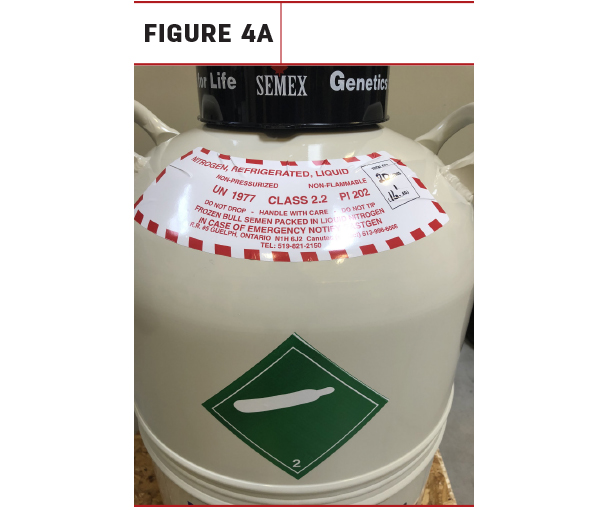 Your A.I. company is required by law to have these labels affixed in the proper locations on the tank prior to delivery. Any tank that is in transport must have these labels replaced or refreshed as needed.
Your A.I. company is required by law to have these labels affixed in the proper locations on the tank prior to delivery. Any tank that is in transport must have these labels replaced or refreshed as needed.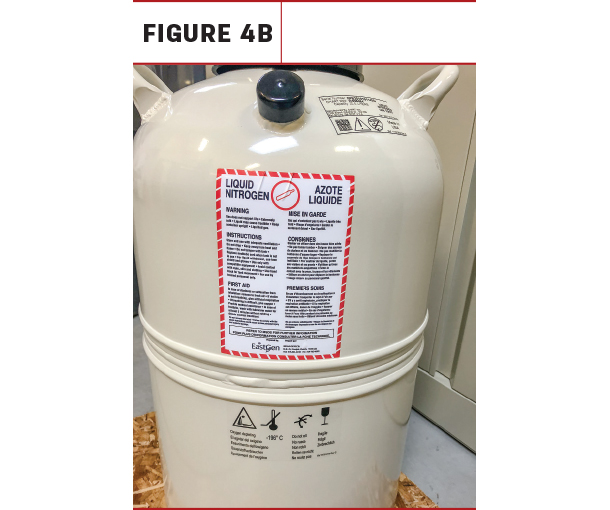
Safety and first aid
As mentioned, provide adequate ventilation in the area where your tank is stored with thought given to the person filling your tank, as extra vapor is produced during filling.
Hang a pair of safety glasses beside your tank, and wear them. A drop of liquid nitrogen in the eye can cause serious damage.
Contact with liquid nitrogen will cause freezing of tissue, much like severe frostbite. Flush the contact area with cool or lukewarm water. For severe burns or blisters, seek medical care immediately.
In a spill situation, nitrogen becomes a gas and displaces oxygen. To a person in that area, symptoms of oxygen deficiency appear quickly – headache, dizziness and eventual unconsciousness. CPR must be performed quickly on a person found in this state.
Proper semen handling at the tank
The inseminator’s success with A.I. starts at the tank. In other words, if semen is not handled properly before loading the breeding gun, conception rates are compromised before one even walks up to the cow.
With the use of cryogenics, bull semen can be stored indefinitely when frozen in the lab and maintained in liquid nitrogen at temperatures of -320ºF. When exposed to temperatures -104ºF, damage can occur to the semen in a matter of seconds, greatly reducing its potency and conception rates will drop.
There is a visible frost line located 4 inches below the top of the neck tube. As seen in Figure 5, temperatures rise dramatically above this point.
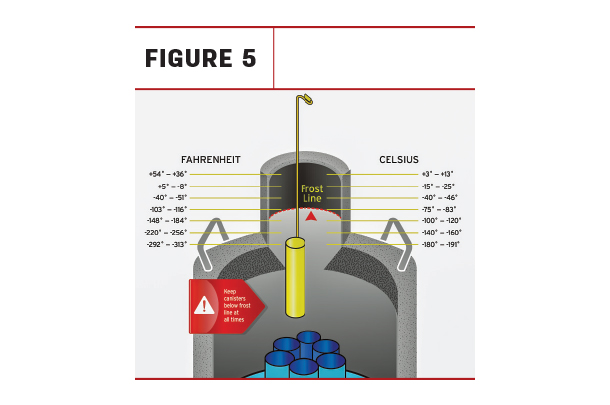 If canisters are raised above this line for even a short period of time, partial thawing can occur. When the canister is lowered back into the tank, re-freezing occurs, and irreparable damage is done.
If canisters are raised above this line for even a short period of time, partial thawing can occur. When the canister is lowered back into the tank, re-freezing occurs, and irreparable damage is done.
The easiest way to manage this problem is to ensure a canister stays just below the frost line while retrieving a straw of semen. An experienced technician will have no trouble using a finger technique to achieve this (Figure 6).
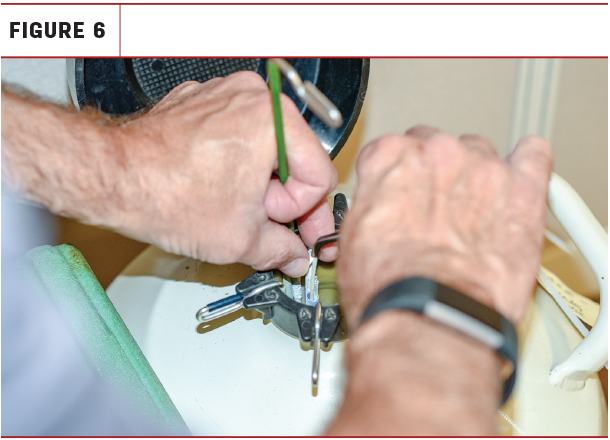 For the owner-inseminator, I always suggest using a clip to secure the canister below the critical zone (Figure 7).
For the owner-inseminator, I always suggest using a clip to secure the canister below the critical zone (Figure 7).
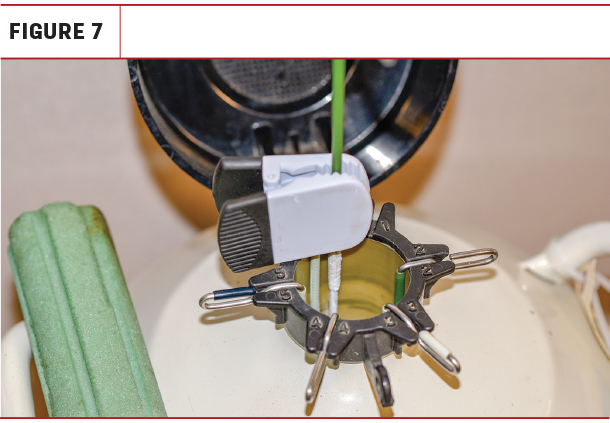 Once we are certain the canister is in a safe place, then we can carefully raise the cane to retrieve a semen straw with a pair of pre-cooled tweezers. The tubes that contain the straws will contain some liquid nitrogen, allowing us about five seconds in the critical zone (the area between the frost line and the top of the neck tube) with the cane.
Once we are certain the canister is in a safe place, then we can carefully raise the cane to retrieve a semen straw with a pair of pre-cooled tweezers. The tubes that contain the straws will contain some liquid nitrogen, allowing us about five seconds in the critical zone (the area between the frost line and the top of the neck tube) with the cane.
During this time, it is imperative to keep the top of the cane below the top of the neck tube.
With the semen straw held tightly in the jaws of the tweezers, a quick shake will dislodge any liquid nitrogen that may be trapped in the plug end of the straw, and it is quickly transferred to your thaw unit, which should be positioned close to the tank.
Every effort is made to limit exposure to the air between the tank and thaw unit in order to avoid sperm-damaging temperature fluctuations.
Once we are confident in our abilities to follow best practices in tank care and semen handling at the tank, then we must follow best practice guidelines for the remainder of the A.I. procedure (straw and gun preparation, semen placement in the cow, etc.). With all these factors considered, and paying attention to all the small details, we can expect better-than-average conception rates.
Remember, an open cow makes no milk or money. ![]()
Bruce Poulin is a reproductive solutions, A.I. training specialist with Semex.
DO’S AND DON’TS
Do
Do keep the tank in a well-lit, well-ventilated area.
Do place a wooden pallet or rigid foam underneath the tank.
Do use mild soap and water to clean the tank as needed.
Do check the nitrogen level regularly.
Do replace the neck cork after use.
Do keep a pair of safety glasses near the tank and use them.
Do lock the tank when not in use.
Do securely tie down a tank in the bed of a truck for transport.
Do keep the top of the can below the neck tube when retrieving a straw of semen.
Do use a clip to secure the canister below the critical zone.
Do use a pre-cooled tweezers to handle semen.
Do limit exposure of the straw to air between the tank and thaw unit.
Don’t
Don’t store the tank directly on concrete.
Don’t store tanks in the milkhouse.
Don’t use a piece of pipe to measure nitrogen levels.
Don’t transport the tank in the passenger seat of a vehicle.
Don’t use a strong jet of water to clean the tank’s exterior.





